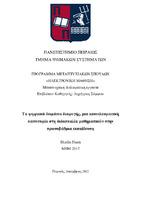Τα ψηφιακά δωμάτια διαφυγής, μια αποτελεσματική καινοτομία στη διδασκαλία μαθηματικών στην πρωτοβάθμια εκπαίδευση

View/
Keywords
Εκπαιδευτικά ψηφιακά δωμάτια διαφυγής ; Λογικομαθηματική σκέψη ; Κίνητρα ; Συνεργασία ; Ηλεκτρονική μάθησηAbstract
Due to the rapid technological developments in recent years and the changes brought because of the pandemic COVID-19, the integration of technology into the educational process has become necessary. Teaching methods and curriculum need to be modernised and harmonised with the current changes of the 21st century, so that schools can motivate students and equip them with the necessary skills to integrate smoothly into tomorrow's society. In the field of mathematics in particular, the poor performance recorded in recent decades, the difficulty for pupils to understand mathematical rules, and the stress caused to pupils, set the basis for making substantial changes, because mathematics is not only a school subject, but also a cornerstone of many aspects of everyday life.
This research thesis investigates whether collaborative problem solving through Digital Educational Escape Rooms can have a positive effect on the teaching of mathematics, increasing students' motivation and performance. For this purpose, a digital educational escape room on Google Slides entitled "The Strongest Solvers" was designed, implemented and evaluated, based on the pedagogical approach CSCL-Computer Supported Collaborative Learning, where learning takes place through social interaction using the internet. The main objective of the e-course is to enhance mathematical skills in the area of logical-mathematical reasoning through the use of web 2.0 tools using a digital escape room.
44 4th grade students attending the 5th Primary School of Vrilissia took part in the study. The survey was carried out, in the context of the school's self-evaluation, in the month of October and lasted a total of four teaching hours in each class of the 4th grade (170 minutes).
The completion of an individual questionnaire by each student was utilized for data collection. In addition, notes and comments from the teacher's participant observation were assessed, as well as the learning outcomes from the supervising teacher's solution of the mathematical puzzles. The results of the research showed that the intervention was successful and all the objectives were achieved.


